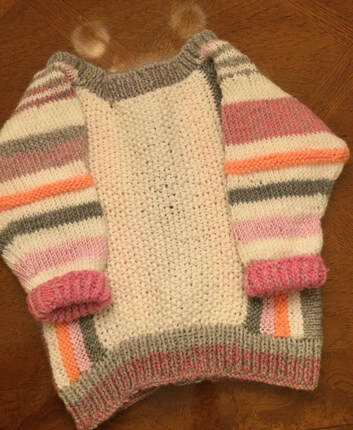 I just love the way stripes and colors play with each other to create fantastic sweaters and cardigans.The works of many artists, especially Stephen West (West Knits), have inspired me to interpret the process of joining the vertical and horizontal knitting to produce sweaters of my own. The model that I frequently use is my darling 5 1/2 year old granddaughter who is growing into size 6. Using her measurements and a sweater that I had already knit for her as a base, I launched my first project. It wa great to incorporate my scraps to bring out pops of color. Remnants of a neon pink-gray multi, light pink, tangerine, and white made for a cheerful combo. Since I ws constructing my piece entirely without pattern, it would be creative experiment -- a kind of knit as you go effort. As I knitted, I added stripes based on contrast and the amount of yarn I had available. I started with an 8 by 11 inch tall white seed stitch panel. Then I turned my work 90 degrees and picked up stitches along the length so that I could work horizontally. Stripes that created welts were purled in grey, pink, tangerine, and white on either side of the back panel. A wider short strip in grey multi made for the transition to the front in shorter rows that allowed for the armhole. Stitches were cast on so that the front of the armhole would match the back. On the front I continued to add stripes that coordinated with the back. For the sleeves, I picked up 60 stitches and knit in the round alternating white with colored stripes The beginning of a row was marked so that decreases at regular intervals could be made before and after the start of the row. The collar, bottom bands, and the button bands were ribbed in pink-gray multi. As a first effort, I was generally pleased with my sweater. I loved the way the stripes and colors played with one another. The sweater was slightly larger than my granddaughter's size frame, but was consistent with the other size six sweaters I had knit or crocheted from a pattern. She is growing and will be wearing this piece into the spring season. This time I started with 3 narrower color blocks, knitted in stock and net, in grey-blue, medium blue, and dark blue. When I turned my work the stripes were knitted in blue green, neon pink, grey blue, medium blue, and dark blue on both sides of the black. Grey-blue was used for side and underarm. Again, I played with an array of stripes to form the shoulder and front. Decreases were made to form the neckline. As in the first sweater,I pickled up about 60 inches from the armhole to make the sleeve. The sleeves were knitted in the round with stripes in the same colors as the body of the sweater. I put a stitch marker into the beginning of the rows so that I could make decreases at regular intervals before and after the marker. The cuffs, neck, bottom, and button bands were ribbed in grey-blue.When I ran out of grey-blue yarn, I just added a few rows of dark blue to get the correct length. The neckline of this sweater was better fit as I made the shoulder at least 1 inch wider on both sides. However, what made this sweater exciting were the fantastic buttons that used most of the colors in the sweater and highlighted the stripes. I could not resist them.
i thoroughly enjoyed this knitting adventure, since I did not know how either sweater would evolve when I started to knit. Now I plan to expand this process to a crocheted version. Please remember folks, the development of these sweaters was a process and not a specific pattern. I hope that you will try to experiment on your own. I invite you to join me on my stitching journey. As always I appreciate your feedback and reflections.
0 Comments
Leave a Reply. |
Archives
November 2022
Categories
|








 RSS Feed
RSS Feed